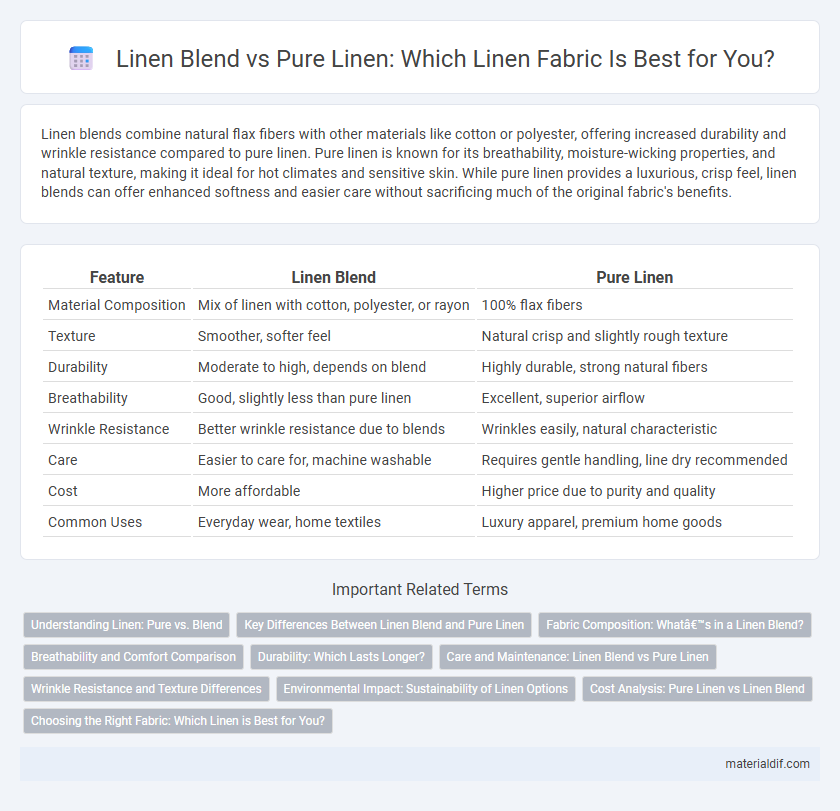Linen blends combine natural flax fibers with other materials like cotton or polyester, offering increased durability and wrinkle resistance compared to pure linen. Pure linen is known for its breathability, moisture-wicking properties, and natural texture, making it ideal for hot climates and sensitive skin. While pure linen provides a luxurious, crisp feel, linen blends can offer enhanced softness and easier care without sacrificing much of the original fabric's benefits.
Table of Comparison
| Feature | Linen Blend | Pure Linen |
|---|---|---|
| Material Composition | Mix of linen with cotton, polyester, or rayon | 100% flax fibers |
| Texture | Smoother, softer feel | Natural crisp and slightly rough texture |
| Durability | Moderate to high, depends on blend | Highly durable, strong natural fibers |
| Breathability | Good, slightly less than pure linen | Excellent, superior airflow |
| Wrinkle Resistance | Better wrinkle resistance due to blends | Wrinkles easily, natural characteristic |
| Care | Easier to care for, machine washable | Requires gentle handling, line dry recommended |
| Cost | More affordable | Higher price due to purity and quality |
| Common Uses | Everyday wear, home textiles | Luxury apparel, premium home goods |
Understanding Linen: Pure vs. Blend
Pure linen is made from 100% flax fibers, offering superior breathability, durability, and a natural texture that enhances with age. Linen blends combine flax with other fibers like cotton or polyester, improving wrinkle resistance and affordability while maintaining much of linen's breathability. Understanding the balance between pure linen's authenticity and blend fabrics' practicality helps in choosing the right textile for comfort, style, and maintenance.
Key Differences Between Linen Blend and Pure Linen
Linen blend fabrics combine flax fibers with materials like cotton or polyester, enhancing durability and reducing wrinkles compared to pure linen, which is made entirely from flax and offers superior breathability and natural texture. Pure linen is more breathable and eco-friendly due to its 100% natural composition, while linen blends provide increased strength and often lower cost. The choice between linen blend and pure linen depends on desired fabric performance, maintenance preferences, and sustainability priorities.
Fabric Composition: What’s in a Linen Blend?
Linen blend fabrics combine natural flax fibers with materials such as cotton, polyester, or rayon, enhancing durability and reducing wrinkles compared to pure linen. Pure linen consists entirely of 100% flax fibers, offering superior breathability and a distinct texture prized for its natural luster and moisture-wicking properties. The specific blend ratio influences fabric weight, softness, and maintenance requirements, making linen blends ideal for versatile everyday wear while pure linen suits premium, breathable garments.
Breathability and Comfort Comparison
Linen blend fabrics combine linen with fibers like cotton or polyester, offering enhanced durability and reduced wrinkles while slightly compromising breathability compared to pure linen. Pure linen excels in breathability due to its natural moisture-wicking and temperature-regulating properties, making it ideal for hot and humid climates. Comfort in pure linen is unmatched for those prioritizing natural fibers, whereas linen blends provide a softer feel with greater wrinkle resistance.
Durability: Which Lasts Longer?
Linen blends typically combine flax fibers with synthetic materials, enhancing durability and resistance to wear compared to pure linen, which is more prone to wrinkling and tearing over time. Pure linen, while breathable and naturally strong, generally requires more delicate care to maintain its longevity, often lasting fewer years under heavy use. Fabric experts highlight that linen blends offer improved resilience and longer lifespan for everyday apparel and upholstery applications.
Care and Maintenance: Linen Blend vs Pure Linen
Pure linen requires gentle washing in cold water and air drying to maintain its breathability and prevent shrinkage, while linen blends often tolerate machine washing and faster drying due to the synthetic fibers. Linen blends typically need less ironing because the added fibers reduce wrinkles, unlike pure linen, which wrinkles easily and benefits from steaming or careful pressing. Both materials should be stored in a cool, dry place, but pure linen demands more delicate care to preserve its natural texture and longevity.
Wrinkle Resistance and Texture Differences
Linen blend fabrics offer improved wrinkle resistance compared to pure linen, making them more practical for daily wear while maintaining a crisp appearance. Pure linen boasts a unique texture characterized by a natural, slightly coarse feel and prominent slubs, which pure linen enthusiasts appreciate for its authenticity. Linen blends often have a softer, smoother texture due to the incorporation of fibers like cotton or polyester, enhancing comfort without sacrificing much of linen's characteristic breathability.
Environmental Impact: Sustainability of Linen Options
Linen blend fabrics often incorporate synthetic fibers, which can increase environmental footprint due to non-biodegradable waste and higher energy consumption in production. Pure linen, derived from flax plants, offers exceptional sustainability with minimal water usage, biodegradability, and lower pesticide requirements. Choosing pure linen supports eco-friendly manufacturing processes and reduces overall ecological impact compared to blended alternatives.
Cost Analysis: Pure Linen vs Linen Blend
Pure linen garments generally incur higher production costs due to the labor-intensive harvesting and processing of flax fibers, which results in a premium retail price. Linen blends often combine flax with cotton or synthetic fibers, reducing overall material and manufacturing expenses, making them more affordable while retaining some of linen's breathability and texture. Consumers seeking durability and the unique feel of natural linen may find pure linen worth the investment despite the higher cost, whereas budget-conscious buyers often prefer linen blends for their cost-efficiency and easier maintenance.
Choosing the Right Fabric: Which Linen is Best for You?
Linen blend combines natural flax fibers with materials like cotton or polyester, enhancing durability and wrinkle resistance while maintaining breathability, making it ideal for everyday wear and easy care. Pure linen offers superior moisture-wicking properties, eco-friendliness, and a luxurious texture that softens with use but requires more delicate maintenance to prevent creasing. Selecting between linen blend and pure linen depends on preferences for fabric performance, comfort, and maintenance effort tailored to your lifestyle.
Linen Blend vs Pure Linen Infographic

 materialdif.com
materialdif.com